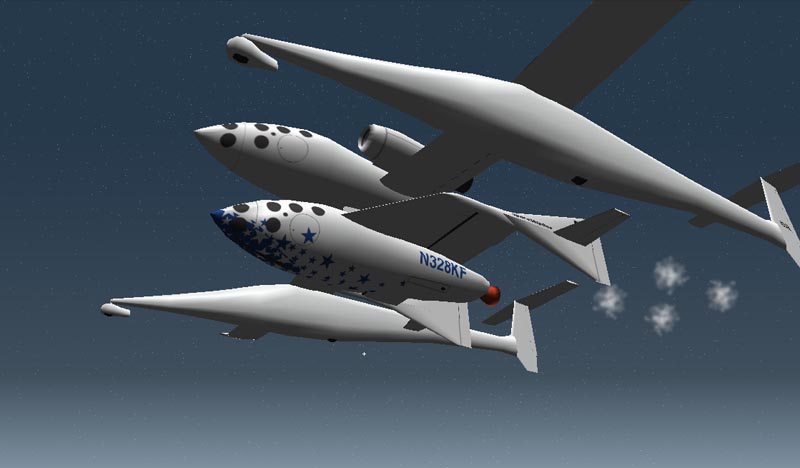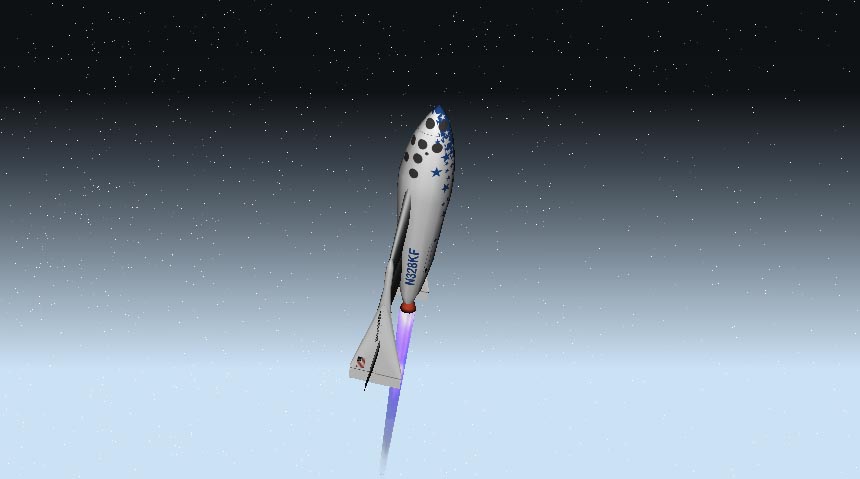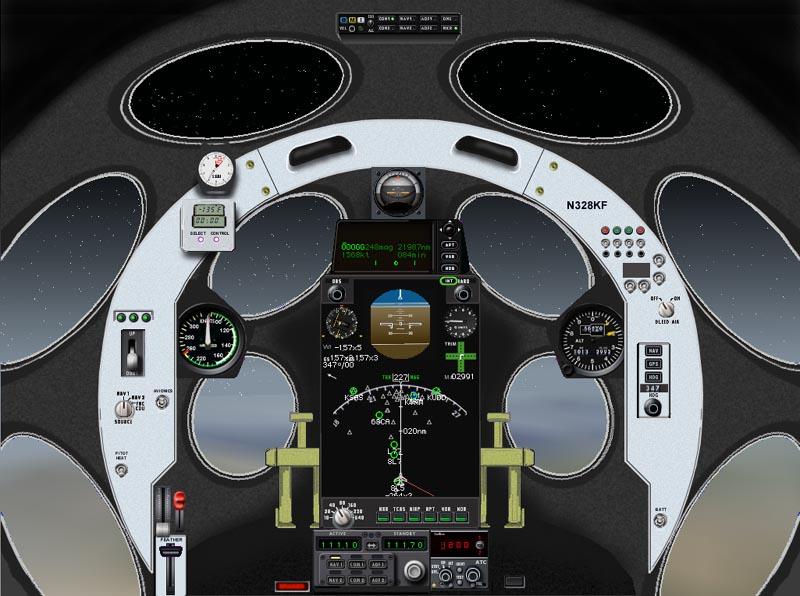


Austin's Adventure: The Space-Trip (August 20, 2005)
(Note: This adventure not yet experienced. This is an advance-copy rough draft based on simulation in X-Plane. The simulation indicates that when I record the REAL experience in a few years, this draft can be used with perhaps some minor corrections, depending on the accuracy of X-Plane!).
The three of us sat in the minimal seats inside of SpaceShip One. In the middle sat our pilot for the flight, and on my left the other passenger (a high-up ex-Boeing guy also along for the thrilling ride). While the pilot was of course flying on Scaled Composite's dime, the Boeing guy and myself had each paid for a "ticket" for our spaceflight. (Though the ticket price was considerably more than a "dime", it was certainly not in the millionaire category of price).
The seats were formed from carbon-fiber "thrones" molded into the fuselage itself, each with 2 simple cushions attached to them, lower and back. Like all of Burt Rutan's creations, the interior of SpaceShip One was pure aero-TECH, NOT luxury. The interior was raw black carbon-fiber, with the outlines to the numerous portholes all lined by perfect circles of epoxy seal. Unlike my other vehicles, this one was NOT lined by leather and curvy stylish ABD plastic... this was all raw carbon-fiber and aluminum with resin and sealant and plexiglass porthole windows, with the few simple systems of the craft readily apparent.
The three of use sat inside the ship, the pilot in front and center, with myself and the other paying passenger slightly behind him and to either side. The feet of myself and the other passenger were about even with the waist of the pilot, so we were to either side and a bit behind, forming a perfect triangle. There was only one display in the craft: a computer display about the size of a laptop screen between the pilots knees that had a big artificial horizon on it's upper half, and a moving map on it's lower half. The artificial horizon had a number of unusual markings on it indicating target pitch and roll, and the moving map had a number of unusual markings on it, indicating how far we could glide from our current position, and how many gliding 360's we could do from our current altitude to wind up at the target altitude of our next fix. No more guessing how many 360's you have to do to make it down to a desired altitude over the field!
The ship was comfortable, though getting in and out required contortions that are best avoided by anyone over 40, and anyone more than about 20 pounds overweight! My 6-foot-3 height was a bit of a squeeze, but manageable. The ENTIRE CRAFT was made out carbon-fiber, of course, with a dozen portholes looking out at all angles, up, down, left, and right. Why the round portholes at all angles? This is because a ROUND window is easiest to pressurize (no "corners" for stress concentrations to build up.. in fact several of the first jetliners ever to enter service were lost in flight when their square windows seperated in flight from the stress concentrations at the corners... thus the rounded edges on all airliner windows in service today). At any rate, on SpaceShip One, pressurization is rather important since you are at 328,000 feet with no spacesuit. Thusly, Burt decided that perfectly ROUND portholes would be the way to guarantee good pressurization with minimal increase in weight. Even the "rounded" edges of the windows of modern airliners are not light enough when you have to rocket to 328,000 feet... every pound counts, so all apsects of weight reduction are optimized... and the windows go to the minimum-weight shaoe of PERFECTLY ROUND WITH NO STRESS CONCENTRATIONS FROM CORNERS and thus MINIMUM WEIGHT to guarantee a good seal even at the vacuum of 328,000 feet.
Bot that is only one type of "round". The OTHER way that the portholes are round is that they curve with the curvature of the fuselage... they are not "flat" circles. The reason for this is not completely obvious to most of us and here is why: We are used to having cockpit windows that are NOT rounded with the fuselage, but are instead FLAT. This is because glass is easiest made FLAT, and the extra weight of the structure required to hold the window FLAT under pressurization loads is not too great. (Remember, any pressurized vessel want to expand to a round thing like a balloon under the pressure... the FLAT cockpit window is TRYING to bow out into a balloon-shape... some weight must be spent in structure to hold it FLAT. With low weight so important in a spaceship though, Burt made ALL the windows, (even the cockpit windows!), CURVED with the round profile of the fuselage. Not a single flat surface in sight. This way, pressurization loads do not try to change the shape of the already-ballooned windows at all.
Since we are going to be gliding down in circles over the Mojave desert, we need to be able to look left and right to see the airport we will land at, so we must have visibility (and therefore portholes) on the left and right. Also we are in a craft with a VERY LOW aspect ratio, this means the nose will be WAY UP in the flare, so we must be able to see DOWN very well to see the runway, so this means we must have portholes that look DOWN. We will also be re-entering the Earth's atmosphere in a vertical dive, and if we want to see where we will be going when we pull up, then we will need portholes on the ROOF of the craft as well, looking UP. This requires portholes looking left, right, up, and down. In short: Portholes all over.
Bottom line:
->you want your windows ROUND to avoid stres concentrations at the corners
->you want your windows curved with the shape of the fuselage to eliminate pressurization distortion
->you want your windows looking every-which-way for the wild flight envelope possible
Burt has foreseen all of this, of course, so the natural evolution, realized here, is to have many small round portholes in the craft, all looking out at every odd angle, up, down, left, and right. The view out the windows makes you feel like you are a tiny shrunken viewer inside the eye of a housefly. A wonderful giant techno-housefly that buzzes through SPACE, that is!
Now, I should mention that we were sitting in this spaceship at around 50,000 feet at a high subsonic speed, and having a near-miss of sorts with another craft: The White Knight. This is the twin-jet, afterburning mothership that is currently carrying us. We are slung underneath it like a big bomb, it's huge ungainly gull-shaped wing above us visible through the upper-lateral portholes, it's long ungainly fuselage above us visible up through the upper portholes, it's huge ungainly boom that holds it's landing gear visible out the portholes to either side of us. So we were in the clear blue sky, getting dark in the upper part of it due to it's rarity at this altitude, and and had the fusleage and booms of the mothership visible out of our portholes as we hung from it. The roar of the White Knights's 2 afterburning engines was audible through our thin, pressurized, carbon-fiber skin. The countdown came and we were suddenly thrown up in our seats as we fell away from the White Knight, the huge gangly mothership seeming to fall UPWARDS away from us in the upper portholes as we actually fell DOWN away from it. Soon it was ahead of us, falling away rapidly as the pilot turned sharply to the right to GET THE HECK OUT OF OUR WAY CAUSE HE KNEW WHAT WE WERE GOING TO DO NEXT! Our pilot pulled up HARD on the stick and our nose came up to 45 degrees... he lifted a guard under his left hand and hit a switch.. then lifted another guard to it's right and hit that switch. With a sudden white-noise scream the rockets behind us ignited and we were pushed back in the seats from the acceleration. Scaled is not releasing the exact rocket thrust and spacecraft weight, but the acceleration was in the vicinity of about 3 to 5 G's. It was a wonderful pure FORWARDS acceleration though, with some DOWNWARDS component as the pilot pulled us up to a pitch of 85 degrees... almost straight up. The portholes that have been filled with sky-blue began to show something else: PURE BLACK DOTTED WITH STARS. A look out the side window to my right showed the blue curve of the earth falling visibly aft as we plunged forwards/up into space. Soon I could see the blue ball that is the Earth below me, the United States stretching out for two thousand miles. The guy on the left saw the Pacific Ocean, and noted to ask him after we land if he saw Hawaii. (We agreed not to talk during the flight though). After about a minute or so, the rocket expended it's fuel of laughing-gas expelled over rubber (!), but the ascent was not even halfway done! With this kind of speed, there is plenty of time to COAST. The craft coasted up for a few minutes as the speed bled off and the three of us were weightless in the cabin. The pilot hit a switch under his left hand, activating one of the two compressed-air systems that sent jets of air to the extremities of the craft for pitch, roll, and yaw control. There was no separate yoke for these reaction jets... instead, moving the stick almost all the way to it's extremity activated the air jets to rotate the craft. There is no fly-by-wire system here at all, so you have to realize that each jet imparts an angular ACCELERATION on the craft, so you have to be sure not to overshoot. If you use up all the air in system A, then you can hit the switch to the right of that to activate system B. The pilot pitched the stick full-forwards to activate the nose-down jets to get the craft pointed down about 45 degrees for re-entry. At first it seems odd to point the nose down 45 degrees, but then you realize the the descent path is almost VERTICALLY straight down, and the craft wants a 45 degree angle of attack for the reentry process... thus the 45 degree nose-down attitude. The view out the lower portholes indicatedd where we were falling, the view out the upper portholes indicatedd Northern California and Canada. Right around this time, the pilot pulled a handle that raised the entire back half of the wing and the tail booms and stabilizers attached to it up 45 degrees. This is called "feathering" the ship, and causes the wing to be at an un-stalled angle of attack, with the horizontal stabilizers trailing smoothly in the wind at about zero angle of attack (good for stability) even though the fuselage is at a 45 degree angle of attack to the wind, thus resulting in very high drag and very good stability. Both of these are needed for the craft to slow down in the upper atmosphere while still under control, thus avoiding a rapid descent into the thick lower atmosphere, which would result in an overload of the structure. As we came hurtling down, the G-load built up gradually until we had something like 4 to 6 G's of acceleration from atmospheric braking. After several minutes, the G came off as we SLOWED DOWN to terminal velocity in this atmosphere. As the pilot unfeathered the ship, the nose came down and the ship accelerated again in it's new low-drag configuration. We were now heading to Scaled Composites Mojave desert flight test center, the center-mounted map showing the airport straight ahead with a light blue line leading up to it. We are still too high, and we arrived over the end of the runway with about ten thousand feet to spare! No problem, a few circles around to dissipate the extra altitude and and we were soon at our pattern altitude right over the end of the runway. The pilot lowered the gear, and then lowered the nose and scooted on down at a comfortable speed until the runway filled all the lower portholes. A nice conventional flare and then the main wheels touched, and then the front skid touched and we dragged to a stop!
Champagne, parties, and a media circus followed, but that is another story!
signed,
Austin Meyer
August 20, 2005
(PS: Bush's second term is going GREAT! Though we were all rather annoyed when Jesse Jackson demanded that third re-count!)


